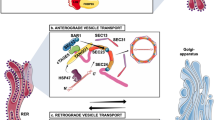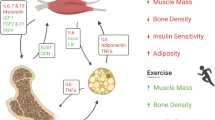Abstract
Extracellular Fatty Acid Binding Protein (Ex-FABP) is a 21 kDa lipocalin, expressed during chicken embryo development in hypertrophic cartilage, in muscle fibres and in blood granulocyte. The protein selectively binds with high affinity fatty acids, preferably long chain unsaturated fatty acids in chondrocyte and myoblast cultures Ex-FABP expression is increased by inflammatory-agents and repressed by anti-inflammatory-agents. In adult cartilage, Ex-FABP is expressed only in pathological conditions such as in dyschondroplastic and osteoarthritic chicken cartilage. We propose that lipocalin Ex-FABP represents a stress protein physiologically expressed in tissues where active remodelling is taking place during development and also present in tissues characterized by a stress response due to pathological conditions.
Similar content being viewed by others
References
Cancedda R, Descalzi Cancedda F, Castagnola P: Chondrocyte differentiation. Int Rev Cytol 159: 265–358, 1995
Castagnola P et al.: Type X collagen synthesis during in vitro development of chick embryo tibial chondrocytes. J Cell Biol 102: 2310–2317, 1986
Descalzi Cancedda F et al.: Developmentally regulated synthesis of a low molecular weight protein (Ch 21) by differentiating chondrocytes. J Cell Biol 107: 2455–2463, 1988
Gentili C et al.: Expression of the extracellular fatty acid binding protein (Ex-FABP) during muscle fiber formation in vivo and in vitro. Exp Cell Res 242: 410–418, 1998
Ferrari S, Battini R, Cossu G: Differentiation-dependent expression of apolipoprotein A-I in chicken myogenic cells in culture. Dev Biol 140: 430–436, 1990
Bedard PA et al.: Rapid repression of quiescence-specific gene expression by epidermal growth factor, insulin, and pp60v-src. Mol Cell Biol 9: 1371–1375, 1989
Kim S et al.: C/EBPbeta (NF-M) is essential for activation of the p20K lipocalin gene in growth-arrested chicken embryo fibroblasts. Mol Cell Biol 19: 5718–5731, 1999
Dozin B et al.: Expression regulation and tissue distribution of the Ch21 protein during chicken embryogenesis. J Biol Chem 267: 2979–2985, 1992
Quarto R et al.: Constitutive myc expression impairs hypertrophy and calcification in cartilage. Dev Biol 149: 168–176, 1992
Quarto R et al.: Modulation of commitment, proliferation and differentiation of chondrogenic cells in defined culture medium. Endocrinology 138: 4966–4976, 1997
Descalzi Cancedda F et al.: The amino terminal sequence of the developmentally regulated Ch21 protein shows homology with amino terminal sequences of low molecular weight proteins binding hydrophobic molecules. Biochem Biophys Res Commun 168: 933–938, 1990
Descalzi Cancedda F et al.: Ch21 protein developmentally regulated in chick embryo belongs to the superfamily of hydrophobic molecules transporters. J Biol Chem 265: 19060–19064, 1990
Descalzi Cancedda F et al.: The developmentally regulated avian Ch21 lipocalin is an extracellular fatty acid-binding protein. J Biol Chem 271: 20163–20169, 1996
Ockner RK, Manning JA, Kane JP: Fatty acid binding protein. Isolation from rat liver, characterization, and immunochemical quantification. J Biol Chem 257: 7872–7878, 1982
Sacchettini JC et al.: Rat heart fatty acid-binding protein is highly homologous to the murine adipocyte 422 protein and the P2 protein of peripheral nerve myelin. J Biol Chem 261: 8218–8223, 1986
Bohmer FD et al.: Identification of a polypeptide growth inhibitor from bovine mammary gland. Sequence homology to fatty acid-and retinoid binding proteins. J Biol Chem 262: 15137–15143, 1987
Suzuki M et al.: The complete amino acid sequence of human P2 protein. J Neurochem 39: 1759–1762, 1982
Matarese V, Bernlohr DA: Purification of murine adipocyte lipid-binding protein. Characterization as a fatty acid-and retinoic acid-binding protein. J Biol Chem 263: 14544–14551, 1988
Ashbrook JD et al.: Long chain fatty acid binding to human plasma albumin. J Biol Chem 250: 2333–2338, 1975
Manduca P et al.: Synthesis and secretion of Ch 21 protein in embryonic chick skeletal tissues. Eur J Cell Biol 50: 154–161, 1989
Cermelli S et al.: Extracellular fatty acid binding protein (Ex-FABP) modulation by inflammatory agents: ‘Physiological’ acute phase response in endochondral bone formation. Eur J Cell Biol 79: 155–164, 2000
Author information
Authors and Affiliations
Rights and permissions
About this article
Cite this article
Descalzi Cancedda, F., Dozin, B., Zerega, B. et al. Ex-FABP, extracellular fatty acid binding protein, is a stress lipocalin expressed during chicken embryo development. Mol Cell Biochem 239, 221–225 (2002). https://doi.org/10.1023/A:1020548118241
Issue Date:
DOI: https://doi.org/10.1023/A:1020548118241




